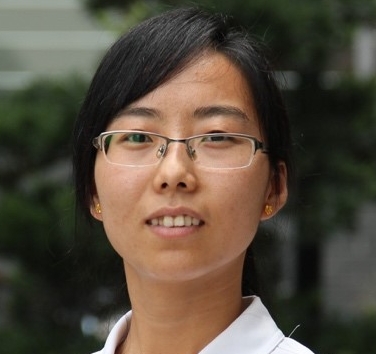STE Highlights, September 2021
Awards and Recognition
Nuclear Engineering and Nonproliferation
University students explore nuclear nonproliferation with LANL experts in a virtual environment
Awards and Recognition
MPA technology recognized with FLC awards
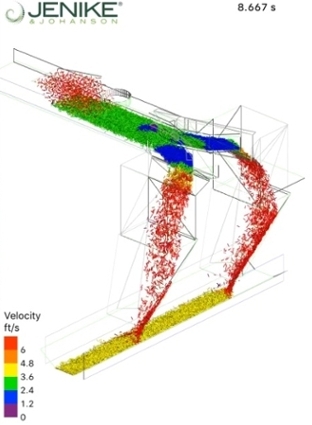
Wire diagram of “smart” chutes demonstrating the innovative functionality to actively discard problematic biomass material with high moisture content. (Credit: Jenike & Johanson)
Innovative technology developed by Los Alamos researchers and collaborators has been recognized with 2021 Federal Laboratory Consortium for Technology Transfer Mid-Continent Regional Awards. Two Laboratory projects, developed by multidisciplinary project teams, earned recognition in the “Notable Technology” category.
“QED: Quantum ensured defense of the smart electric grid” is a cutting-edge technique that uses single particles of light for encryption and authentication to keep information safe and the power grid secure. Relying on fundamental properties of quantum physics, the use of photon technology in Laboratory-designed transmitter and receiver devices results in an unhackable method for sending information between generators, substations, and into homes. The project team consists of Raymond Newell, Nicholas Dallman (MPA-Quantum, MPA-Q); Claira Safi (Space Data Science and Systems, ISR-3); and Justin Tripp (Information Sciences, CCS-3).
“Smart transfer chutes and sensors,” created by LANL in tandem with Jenike & Johanson, uses integrated acoustic moisture sensors to improve the operational reliability of biorefineries. Moisture-laden biomass can clog conveyors and chutes that direct material around a refinery; real-time monitoring provided by moisture sensors can help redirect material for further drying, ensuring uninterrupted refining. The LANL team includes Troy A. Semelsberger, Cristian Pantea, John Greenhall, Hung Doan, Craig Chavez, Pavel Vakhlamov, and Christopher Hakoda (Materials Synthesis and Integrated Devices, MPA-11). The Jenike & Johanson team includes David Craig and Carrie Hartford.
The FLC, a nationwide network of more than 300 federal laboratories, agencies, and research centers, aims to foster commercialization best practice strategies and opportunities for accelerating federal technologies from out of the labs and into the marketplace. Its awards program annually recognizes federal laboratories and their industry partners for outstanding technology transfer achievements.
Xiaojing Wang recognized for hydrogen and fuel cell research
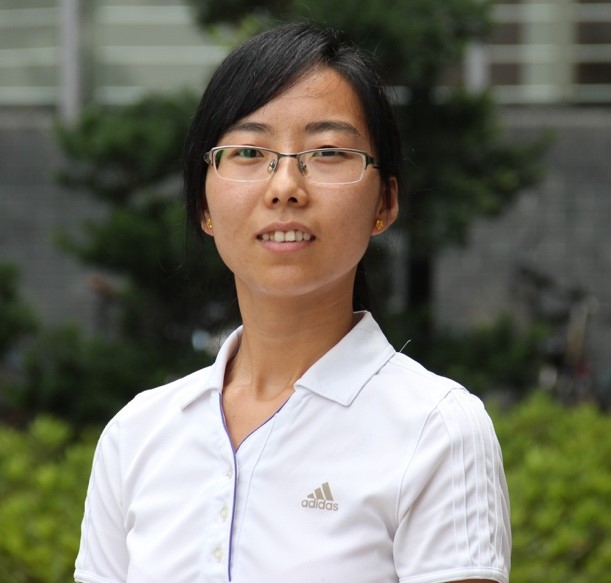
Xiaojing Wang
Xiaojing Wang (MPA-11) was recently named a runner-up for the 2021 Hydrogen and Fuel Cell Technologies Office (HFTO) Postdoctoral Recognition Award. Sponsored by the Department of Energy’s Office of Energy Efficiency and Renewable Energy, the award is presented to postdoctoral fellows from DOE national laboratories for outstanding contributions in identifying research solutions to hydrogen and fuel cell research challenges.
During her tenure at the Lab, Wang has made major contributions to the development of novel mixed-conducting catalyst supports and oligomer-based electrode ionomers through a project funded by the Laboratory Directed Research and Development (LDRD) Program.
She has also studied the effects of electrode thickness and platinum distribution on transport performance and durability, work funded by HFTO through the Advanced Electrocatalysts through Crystallographic Enhancement project, which has become part of the Million Mile Fuel Cell Truck consortium.
Wang, a postdoctoral research associate on the MPA-11 Fuel Cells and Electrochemical Sensors team, has a doctoral degree in materials science and engineering from the University of California, Riverside.Chemistry
Controlling the stereochemical features of metal complexes
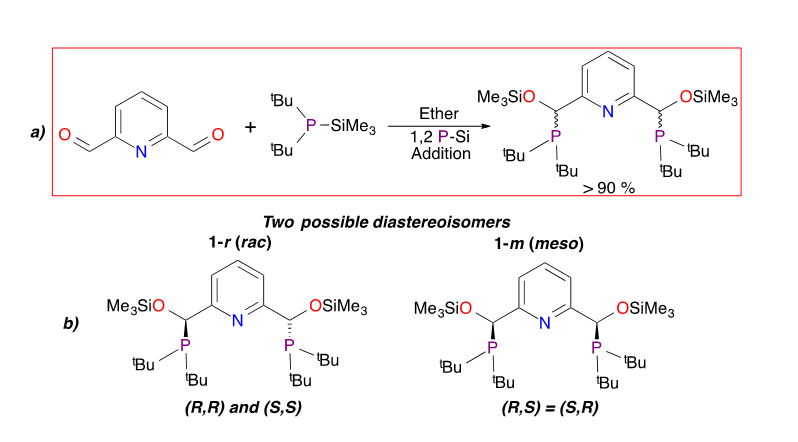
Synthesis (a) resulting in two possible diasterioisomer pairs (b).
Scientists in the Inorganic, Isotope, and Actinide Chemistry group (C-IIAC) recently published a paper in the journal Organometallics that furthers the understanding of the role metal complexes can play in stereochemistry. Representing a new addition to the fields of template synthesis and stereochemistry, the work on stereochemical features of transition metal coordination complexes was featured on the front cover of Organometallics. The goal of the current research was to use a template methodology to impart stereoselectivity during the synthesis of a chelate (a type of compound) on a metal.
Stereochemistry is a discipline of chemistry that focuses on stereoisomers, molecules that have the same molecular formulas as each other but which differ in three-dimensional orientation. The differing orientations result in different physical or biological properties. In coordination chemistry, a template reaction is one that occurs adjacent to the metal center and that produces different products than if the metal were absent. Control over the stereoselectivity of complexes has generally used optically-pure organic fragments that encourage the complexes towards a particular stereoisomer. Metal centers have also been used to assist in chemical transformations.
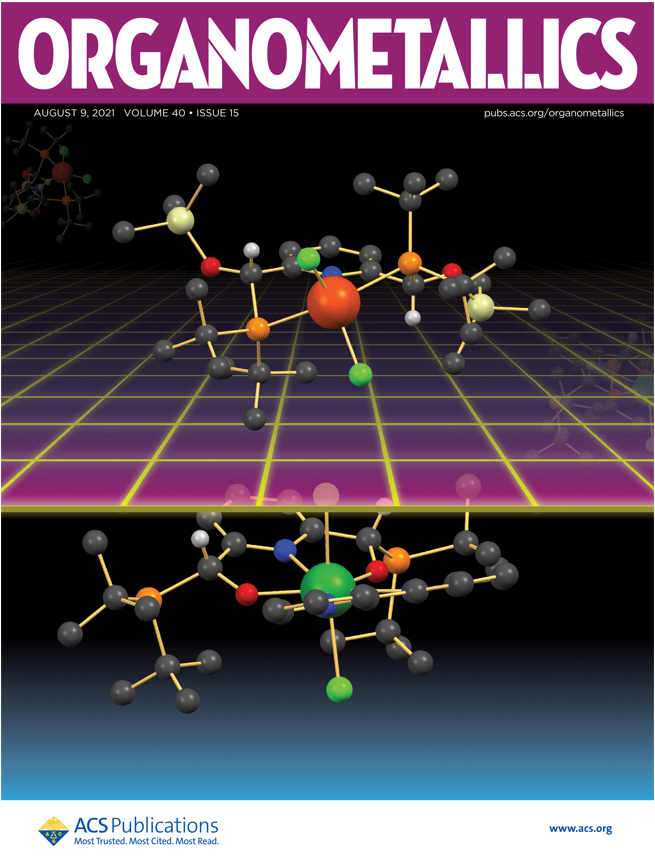
The researchers circumvented product mixtures using a template synthesis on iron and uranium. Using a metal center as a template (represented by the metallic grid in this image), both iron and uranium complexes could be isolated with high selectivity.
The stereoisomer synthesized in this work was (OTMS)PNPtBu (1-r/m). This complex has two possible resulting diastereoisomer pairs (Figure 1). The research findings demonstrate a new method for generating meso diastereoselective iron and uranium complexes. Iron complexes of this class of molecules can be used as catalysts for a number of transformations, for example, the hydrogenation of olefins and carbonyl groups.
The interest for this reaction and the generation of ONO2--supported uranium complexes is much more fundamental for uranium than for iron. For instance, the observed difference in the final ligand product arises from fundamental differences between the two metals, yet the product retains the same diastereoselective result. These differences in reactivity can be leveraged and applied to areas such as lanthanide/actinide separations, actinide-element multiple bond formation, and even to the generation of actinide catalysts for small molecule transformations.
The entirety of this report brings LANL scientists and the Heavy Element Chemistry program closer to being able to control actinide reactivity down to the level of the f-electron.
Funding and Mission
This work was funded by the DOE Office of Science, Office of Basic Energy Sciences, Heavy Element Chemistry program. Postdoctoral support was provided in part by the Glenn T. Seaborg Institute and Harold Agnew National Security Fellowship. This work supports the Materials for the Future capability pillar.
Reference
“Diastereoselective Template Synthesis on Iron and Uranium,” Organometallics, 40 (15) 2389 (2021); https://doi.org/10.1021/acs.organomet.1c00296. Authors: Stephanie H. Carpenter, Brennan S. Billow, and Aaron M. Tondreau.Materials Physics and Applications
Giant magnetoelectric coupling and low magnetic field switching demonstrated in spin crossover complex
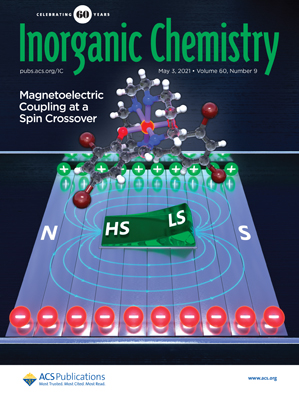
Inorganic Chemistry featured the work on its cover. Here, a Mn3+ complex in shown magnetoelectric coupling at a spin crossover. The spin crossover between the high-spin (HS) and low-spin (LS) states (shown as a switch) triggers a structural phase transition between different polar space groups. The graphic shows an artist's rendition of the electric and magnetic field lines in the sample.
In work recently published in Inorganic Chemistry, LANL researchers in the National High Magnetic Field Laboratory-Pulsed Field Facility (MPA-MAGLAB) and their international collaborators investigated the combination of relatively low magnetic field switching and giant magnetoelectric (ME) coupling in a molecule-based spin crossover (SCO) complex. The combination showcases the potential for applications in spin crossover materials.
Magnetoelectric coupling occurs when a material’s magnetic field influences the electric polarization and dielectric constant, the amount of electric energy storage of a material. Such coupling may also occur when the electric field influences the magnetization. The intriguing materials phenomenon has applications that range from electric control of spacers between magnetic qubits sensors to data storage, tunable antennas, and other frequency devices. However, not all of the materials needed to realize these diverse applications have been discovered.
LANL researchers and their collaborators departed from traditional studies using inorganic oxides with ordered magnetic spin orientations. Their investigation of the phenomena of field switching and giant ME coupling in an SCO complex indicates the potential of SCO materials for future applications involving magnetoelectric coupling. Those applications may include switching, magnetic and electric sensing, and controlling quantum computers.
The research team conducted research on single crystals and reported ME coupling—near the SCO critical temperature—between spin state, structure, and electric polarization in the Jahn Teller complex due to a first order phase transition. Notably, the SCO behavior is driven by a field as low as 8.7 T, which is remarkably low compared to most other magnetic-field-induced SCO materials. The study demonstrates a giant magnetoelectric effect with a field-induced electric polarization change that is one-tenth of the record for any material.
Funding and Mission
The work supports the Lab’s Energy Security mission and its Materials for the Future science pillar. The LANL science portion of the research was driven and funded by M2QM, the Center for Molecular Magnetic Quantum Materials, an Energy Frontier Research Center funded by the DOE, Office of Science, Basic Energy Sciences. The NHMFL-Pulsed Field Facility provided uniquely high magnetic fields and fast pulsed fields that improve measurement sensitivity to ME coupling. The NHMFL is funded by the National Science Foundation, the state of Florida, and the U.S. DOE. The work supports the Lab’s Energy Security Mission and Materials for the Future capability pillar.
Reference
“Giant Magnetoelectric Coupling and Magnetic-Field-Induced Permanent Switching in a Spin Crossover Mn(III) Complex,” Inorganic Chemistry, 60, 9, 6167 (2020). DOI: https://doi.org/10.1021/acs.inorgchem.0c02789. Authors: Vivien S. Zapf, Shalinee Chikara, Xiaxin Ding, Franziska Weickert (National High Magnetic Field Laboratory-Pulsed Field Facility, MPA-MAGLAB); Grace G. Morgan, Vibe B. Jakobsen, Emiel Dobbelaar, Conor T. Kelly (University College Dublin); Jie-Xiang Yu, Hai-Ping Cheng (University of Florida); Elzbieta Trzop, and Eric Collet (CNRS, Institut de Physique de Rennes).
Technical contact: Vivien ZapfNuclear Engineering and Nonproliferation
University students explore nuclear nonproliferation with LANL experts in a virtual environment
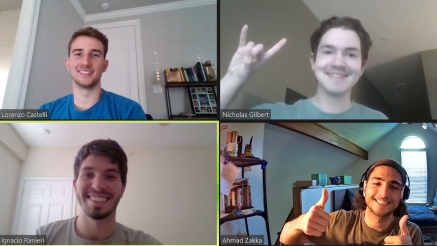
Members of the Spring 2021 team from the University of Texas–Austin meet virtually with Laboratory expert Carolynn Scherer, Systems Design and Analysis (NEN-5), to discuss progress on the students’ design project.
As part of its mission to recruit, educate, and retain a new generation of U.S. experts in international nuclear safeguards, DOE NNSA’s Office of Nonproliferation and Arms Control partners with national laboratories, including Los Alamos National Laboratory, and universities through the Human Capital Development Program to introduce engineering students to the field of international safeguards via a Safeguards by Design (SBD) Challenge. Nuclear safeguards are a set of technical measures that help independently verify that nuclear facilities are not misused and that nuclear material is not diverted from peaceful uses.
The COVID-19 pandemic has forced universities to cancel most classroom instruction and limit direct student-professor interactions, but LANL adapted the project to a fully remote format. That redesign allow students to continue to work with Laboratory experts and gain hands-on experience designing international nuclear safeguards tools.
In 2021, mechanical engineering students from the University of Rhode Island (three teams) and the University of Texas at Austin (one team) virtually met with Laboratory personnel. At the start of each SBD Challenge, a team of LANL subject matter experts provided students an overview of the International Atomic Energy Agency, the nuclear fuel cycle, and the SBD approach. Experts worked with students to describe and illustrate their prototypes. Typically, in non-virtual formats, students are tasked with incorporating SBD approaches into Senior Capstone Design Projects. Although the virtual format prevented students from physically building the prototypes and the LANL team could not oversee final testing onsite, the students continued to meet with one another and receive virtual guidance from the technical experts.
Despite the roadblocks, students found the course successful and reported a new understanding of international nuclear safeguards. They applied the lessons of mechanical engineering to the field of nuclear nonproliferation as they learned how safeguards needs interact with standard engineering requirements. The result was a multidisciplinary culmination of their undergraduate studies.
Having made the smooth transition to a virtual environment, the 2021 teams have already started meeting virtually. Once again, the Laboratory is working with teams from the University of Rhode Island and the University of Texas-Austin, while exploring an additional collaboration with the University of Maryland.
Funding and Mission
The program is funded through DOE NNSA Office of International Nuclear Safeguards/Human Capital Development Program (NA-241) and supports the Lab’s Global Security mission and the Science of Signatures capability pillar.
Technical Contact: Olga Martin
Physics
Ultrafast X-ray provides new look at plasma discharge breakdown in water
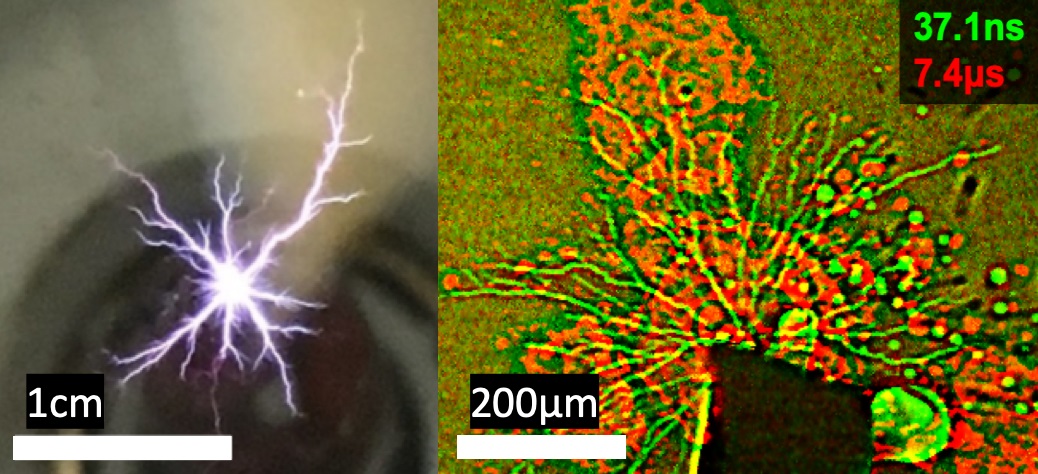
(Left) Visible image of the lightning in water phenomenon with a long integration/exposure time; (right) X-ray image of the phenomenon with an integration/exposure time less than 100 picoseconds and better spatial resolution. A picosecond equals one-trillionth of one second, or one one-thousandth of a nanosecond.
Lightning is fast, but how fast? A Laboratory collaboration recently turned to synchrotron X-rays for an answer. The story of the discovery of the connection between electricity and lightning is well-known—in the 1700s, Benjamin Franklin, unaware of the danger of the electrical forces he was corralling, sent a key on a kite into the churn of a storm cloud. In the subsequent centuries, through experimentation and calculation, much has been learned about lightning, or plasma.
But unanswered questions about the science of ultrafast processes such as plasma remain, the search for answers hindered in part by the limited technological capacity to capture images. In a setting more controlled than Franklin’s thunderstorm, a research team led by laboratory scientist Zhehui (Jeph) Wang of the Thermonuclear Plasma Physics (P-4) group has captured the first sub-nanosecond image of electrical discharge in water. The research was described in a recent paper published in Physical Review Research.
Measured in nanoseconds or even sub-nanoseconds, ultrafast plasma processes are still not well-understood at a basic level. (Beyond those fundamental lines of study, plasma is important in applied contexts such as water treatment or in medicine, to treat disease, or to conduct surgery.) The speed of plasma reactions in water has simply outpaced the ability to capture them by conventional imaging. And, if captured, the optical emission of the plasma burst obscures the details of the process from view. The multidisciplinary team from Los Alamos leveraged a novel electrode-in-water setup built by graduate students Chris Campbell and Xin Tang of Texas A&M University, under the direction of Associate Professor David Staack. Joined by scientists at Argonne National Laboratory beamline 32ID, the Los Alamos team used a state-of-the-art synchrotron X-ray Advanced Photon Source (APS) to resolve the imaging problems.
The fast-imaging X-rays were able to capture images at the rate above 200,000 images per second, or approximately 153 nanoseconds between images. That rate of speed was just enough to capture one single image of the plasma discharge in water. The exposure time of a single X-ray image is only about 50 picoseconds (a picosecond is one one-thousandth of a nanosecond), allowing for unblurred imaging of the ultrafast phenomena.
Plasma, also known as the fourth state of matter, is ubiquitous in the universe. In addition to offering a way to study the open questions related to the speed of lightning, plasma-water interactions are expected to produce new matter phases, providing an excellent platform to examine phase transitions as energetic electrons mingle with molecules of water. The ionized particles quickly multiply, which can turn into a run-away process at a yet unfathomed speed. Where do the first electrons emerge from the electrode? What are the roles of the surface condition of the electrode? With the answers too complex to model or calculate using even the most modern computers, ultrafast imaging provides a shortcut to reveal one of the long-standing secrets of the natural world.
The simple experimental platform of the electrode-in-water setup also offers ample opportunities for multi-disciplinary materials science research. One potential area of research is the very high energy density produced by plasma-water interactions in the experiment, despite less than 1 joule (J) of energy being involved. The sizes of the lightning in water are fractions of a millimeter. Another example of an unresolved question potentially bearing on materials science is how the new phases return to equilibrium, and at what rate.
Several graduate students and postdoctoral researchers played key roles in the initial success of the project. Chris Campbell recently joined the Laboratory as a senior graduate research assistant. Xin Tang recently was awarded a doctoral degree. Another postdoctoral fellow on the project, Yancey Sechrest, is now a staff scientist at the Laboratory. For Wang, the exploration of plasma and fast-imaging has additional benefits in creating a talent pipeline that can shape the Laboratory’s discovery science for years to come.
With the fast-imagining capability demonstrated, Wang is looking ahead to further refining the experimentation and widening the scope of the research. Controlling the experimental environment is a primary consideration—for instance, improving the construction of the electrode in materials and geometry, and trying different chemical solutions. In addition, improved fast-imaging capabilities can be employed through advances in imaging hardware and software. Given fast-imaging’s importance in the Lab’s mission, including mesoscale science, shockwave experiments, and laser-driven experiments such as inertial confinement fusion research, Wang hopes that researchers in predictive science, in simulation, and even in artificial intelligence may also benefit from future iterations of the research.
Through the novel combination of the X-ray synchrotron, ultrafast imaging, and the compact plasma device, the structures and properties of lightning in water may now be better understood, in addition to a broad range of scientific possibilities that researchers can truly visualize for the first time.
Mission and Funding
Research was supported by the LANL Office of Experimental Sciences, C2 and C3 programs. Research at Texas A&M University was supported in part by the Texas A&M Foundation through the Sallie and Don Davis ’61 Career Development Professorship. In addition, this research used resources of the Advanced Photon Source, a U.S. Department of Energy (DOE) Office of Science User Facility operated for the DOE Office of Science by Argonne National Laboratory under Contract No. DE-AC02-06CH11357. This research supports the Laboratory’s Energy Security Solutions mission and the Materials for the Future capability pillar.
Reference
“Ultrafast x-ray imaging of pulsed plasmas in water,” Physical Review Research 3, L022021 (2021); DOI: https://doi.org/10.1103/PhysRevResearch.3.L022021. Authors: Christopher Campbell, Xin Tang, Yancey Sechrest, Kamel Fezzaa, Zhehui Wang, and David Staack.
Technical Contact: Zhehui (Jeph) Wang
Theoretical
New silicon allotrope offers improved properties
Pentagon-rich silicon allotrope Si22 is predicted to surpass the sunlight absorption capability of traditional silicon. Clean energy production would benefit from the integration of Si22 as the fundamental block in a next generation of solar cells.
Despite the large amount of new materials discovered in the last decades, silicon (Si) remains as the element of choice to design commercial solar panels. Abundant and relatively inexpensive, well-understood as a semiconductor material, and with an established production process, silicon is the building block of many important electronics, including solar cell technology. For all its usefulness, though, silicon remains a relatively poor absorber of sunlight.
As described in a paper recently published in the journal Nano Letters, Physics of Condensed Matter and Complex Systems (T-4) group researcher Alejandro Lopez-Bezanilla and research collaborator Peter Littlewood (Argonne/UChicago) predict and provide theoretical insight into the electronic, mechanical, and optical properties of Si22, a new material composed of only Si atoms arranged in a pentagonal geometry. This Si allotrope shows promise for excellent photovoltaic performance, critical to solar cells technologies, and may also have important applications in areas such as carbon sequestration and quantum computing.
Target properties in semiconductor research include electronic gap width (or band gap) and peak of absorption of photon energy, which is in part determined by the band gap width. A band gap is a fundamental feature of a semiconductor such as silicon that determines how much energy is required to excite one electron from its current energy level to a higher energy level where the electron can move freely. A semiconductor is transparent to sunlight unless the energy of the incident photon is the right amount to bridge its gap.
A semiconductor integrating a solar cell with a small band-gap can absorb light but produces a low voltage. A too large band-gap yields a high voltage but a small electron flow because only a small amount of solar radiation is harvested. There is an optimal band-gap that meets the right balance, and is the goal of scientists to find materials meeting that property.
The research by Lopez-Bezanilla and Littlewood also focuses on the creation of magnetic moments. When hydrogen (H) is introduced into Si22 cages, the electron orbitals impacted are very localized nearby the foreign atom. That is, the magnetic moment created is not distributed widely throughout the atomic structure, but concentrated and protected from the surrounding environment. This protection can have implications at very low temperatures vis-à-vis its utilization in quantum computing.
Lopez-Bezanilla analyzed the phonon modes of the new material—the way the structure vibrates, a key indicator of structural stability. In Si22, at very low temperatures the type of Si atoms H attaches to slightly vibrate while the surrounding atoms are not mobile. The stability could provide an advantage for quantum computing, where the infrastructure operates at very low temperature to reduce vibration that interferes with computing processes.
The allotrope Si22 also has potential for carbon sequestration. With its hollow structure, Si22 could allow for molecules to be incorporated within the compound. That approach could enable carbon dioxide to be sequestered (removed from the atmosphere) and caged inside the structure. Reducing the amount of carbon dioxide in the atmosphere may mitigate global climate change.
Lopez-Bezanilla has laid a foundation for the potential of the new material, and experimentation would need to follow up to further test the material’s properties. Designing and understanding the properties of the new material is the first step, and the first step is taken.
Funding and Mission
The research supports the Lab’s Energy Security Solutions mission and the Materials for the Future capability pillar.
Reference
“Exceptional Radiation Absorption in a Pentagon-Based Si Allotrope,” Nano Letters, 21, 10, 4287 (2021); https://doi.org/10.1021/acs.nanolett.1c00549. Authors: Alejandro Lopez-Bezanilla (T-4) and Peter Littlewood (Argonne National Laboratory, University of Chicago).
Technical Contact: Alejandro Lopez-Bezanilla


